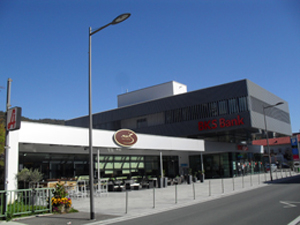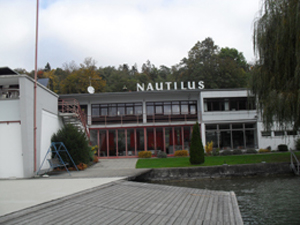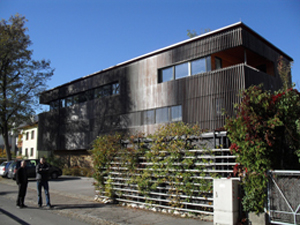| Card n. | Description | Locality | Linked sites |
| 102 | The Modern Architecture of Wörthersee Lake | Wörthersee | |
| Contemporary Architecture (AC) |
 |
 |
 |
| 9. Bank und Geschäftszentrum 2009, Pörtschach am Wörthersee | 29. Ruderverein Nautilus, Boat-and clubhouse | 34. Atelier-Wohnhaus am Lendkanal |
- Description
- How to get there
- Interesting facts
- Bibliography
The buildings around the Wörthersee lake are proof that different construction styles from different periods can coexist in harmony, although the term Wörthersee architecture generally refers to the buildings completed between the late 19th century and the early decades of the 20th century on the banks of the lake or in the surrounding area.
The development of tourism and the enhancement of the lake have continued over the years to welcome visitors who love the area, creating alternative architectures and styles that have reflected the change in the type of client. The examples chosen to represent modern architecture have highlighted projects of significant technological and symbolic value, presenting buildings whose qualities allow them to be considered a model for those who continue to associate tourism with relaxation and leisure. The lines of the contemporary architecture around Wörthersee lake speak their own language, and are functional, linear and in harmony with the surrounding environment. This is clear if we look at examples such as the famous “Castle on the Wörthersee" at Velden, where earlier building elements have been enhanced with the addition of more contemporary features.
The examples range from the Ruderverein Nautilus, designed by the architect Rolf Hass on the outskirts of Klagenfurt in 1960, to the Seehaus Sigitz holiday apartments at Krumpendorf, built in 1968 by Ferdinand J. Brunner, featuring a modern, linear style, with large windows and concrete panels typical of the 1960s, and the more structural Seevilla by the architect Gosch, with a hull-shaped roof reminiscent of the Sydney Opera House by Jørn Utzon.
This building system is also evident in more recent constructions, such as the new Park Hotel by Kurt Köfer (1963) or the BKS - Centrum by Reinhold Wetschko (2009), both in Pörtschach, or the Wörthersee pharmacy (2006) by Karlheinz Winkler, which received an award in 2006 for the construction system adopted (a ground floor in glass throughout, on top of which is an upper floor covered in metal, with large windows arranged in a line); or the multi-function Sicherheitszentrum complex by Peyker+Domenig (2006) in Velden, although here the shape of the construction is subordinated to the activities that take place there, since the building hosts the Fire Service, the Red Cross and the ice rink.
In the holiday apartments, on the other hand, a closer spatial-functional link with tradition has been maintained, despite the innovative use of wood, steel and glass. The concept expressed by the Haus G by Reinhold Wetschko (2003), the Seehaus Columbia (2005) by Stefan Traninger or the Seehaus S (2004) by the Limit Architects studio, all in Pörtschach, or the Sommerhaus B (1995) by Andreas Behmel in Maiernigg and the Haus P (2006) by Reyner Schwarz in Auen, is a “dialogue” with the lake, in which the internal space looks onto and admires the lake, just as was the case with the early 20th century dwellings.
The tradition of using wood as a building material is well represented by the project-competition for the Wohnhaus V atelier (1989) by Klaus Maggior in Krumpendorf, and especially in the Seehaus S, already mentioned, and the Seespitz restaurant (2007) by Jabornegg+Palffy in Velden – a building featuring large terraces and a bathing establishment next to it built in wood in an extremely classic, functional style. Wood is also widely used to cover/decorate traditional buildings, as is the case of the Lakeside Technology Campus (2005) by Eger, Fercher and Gündler, or the Atelier-Wohnhaus by Klaura+Kaden, a house with a passive heating system that won the 2007 Carinthia Region award for constructions built using wood. Both of the latter are in Klagenfurt.
Buildings boasting new technological features are also evident, such as the Pyramidenkogel in Keutschach, by the above-mentioned Klaura+Kaden studio, with a metal structure that rises up on the hills south of Maria Wörth, or the new tower with 100-metre-high platforms and supports that allow the observer to admire the whole of the Wörthersee lake.
The historical and modern architectures along the Wörthersee lakeshore can be reached by following the A23 Udine – Tarvisio and then the E55 / A2 in Austria.
From the province of Belluno, via Cortina (SS51), the Monte Croce Comelico (SS52) or Misurina (SP49) passes will take you into the province of Bolzano in the Upper Pusteria (SS49) area, and from there across the border at Prato Drava, go along the E66 – 100 until Lienz and then in the direction of Spittal to the Drava – Klagenfurt.
ACCESSIBLE: These are buildings of various different kinds, and as is also the case in Italy, those that are publicly owned are open and may be visited, while the historical villas and modern private homes are obviously closed to the public, although the architectural features of interest here can be admired from the lake
MUNICIPALITY AND PLACES: Auen, Dellach, Maria Wörth, Sekirn, Maiernigg, Klagenfurt, Krumpendorf, Pörtschach, Velden.
GEOGRAPHICAL COORDINATES: reference is to the centre of Wörthersee lake
46°37’’30’ N – 14°09’’11’ E
or X 433958 N or Y 5164264
PROVINCE: Carinthia
FILE COMPILED BY: Alfarè - Lonzi
Wörthersee lake is in Carinthia, a region popular with tourists not least because of the other lakes that can be found there: Faaker, Keutschacher, Klopeiner, Millstatt, Ossiacher, Pressegger and Weissen, as well as many other smaller ones.
The region is also crossed by the Drava and by numerous affluents such as the Möll, Lieser, Gurk, Lavant and Gail, which lend their names to the respective valleys.
Like the province of Belluno, the Carinthia region boasts a wealth of establishments and structures that exploit hydroelectric energy, serving much of Austria as well as the other European countries that border on it.
The house of Carinthian architecture, D. Muller, H. Kramer, B. Mack. Klagenfurt, 2009.
http://www.woerthersee-architektur.at

